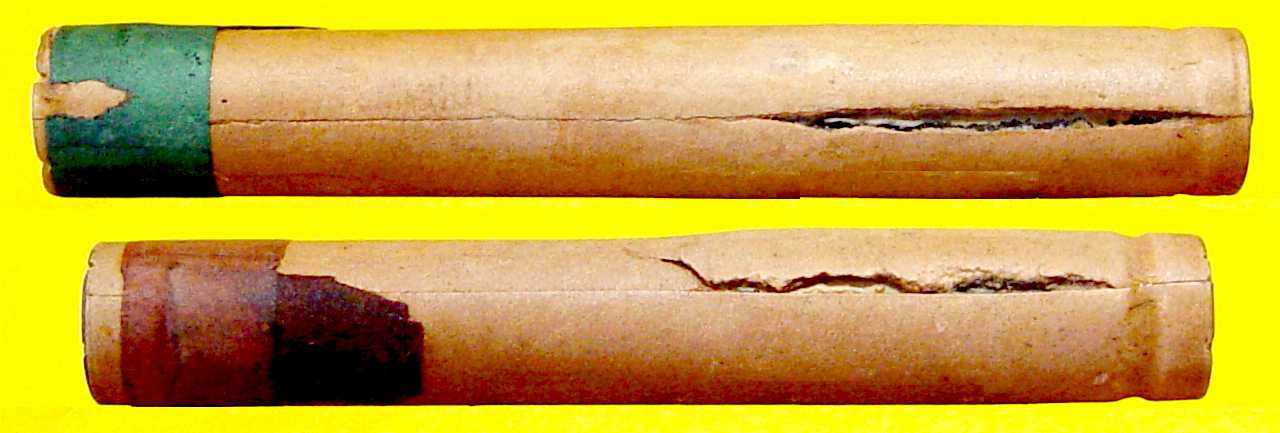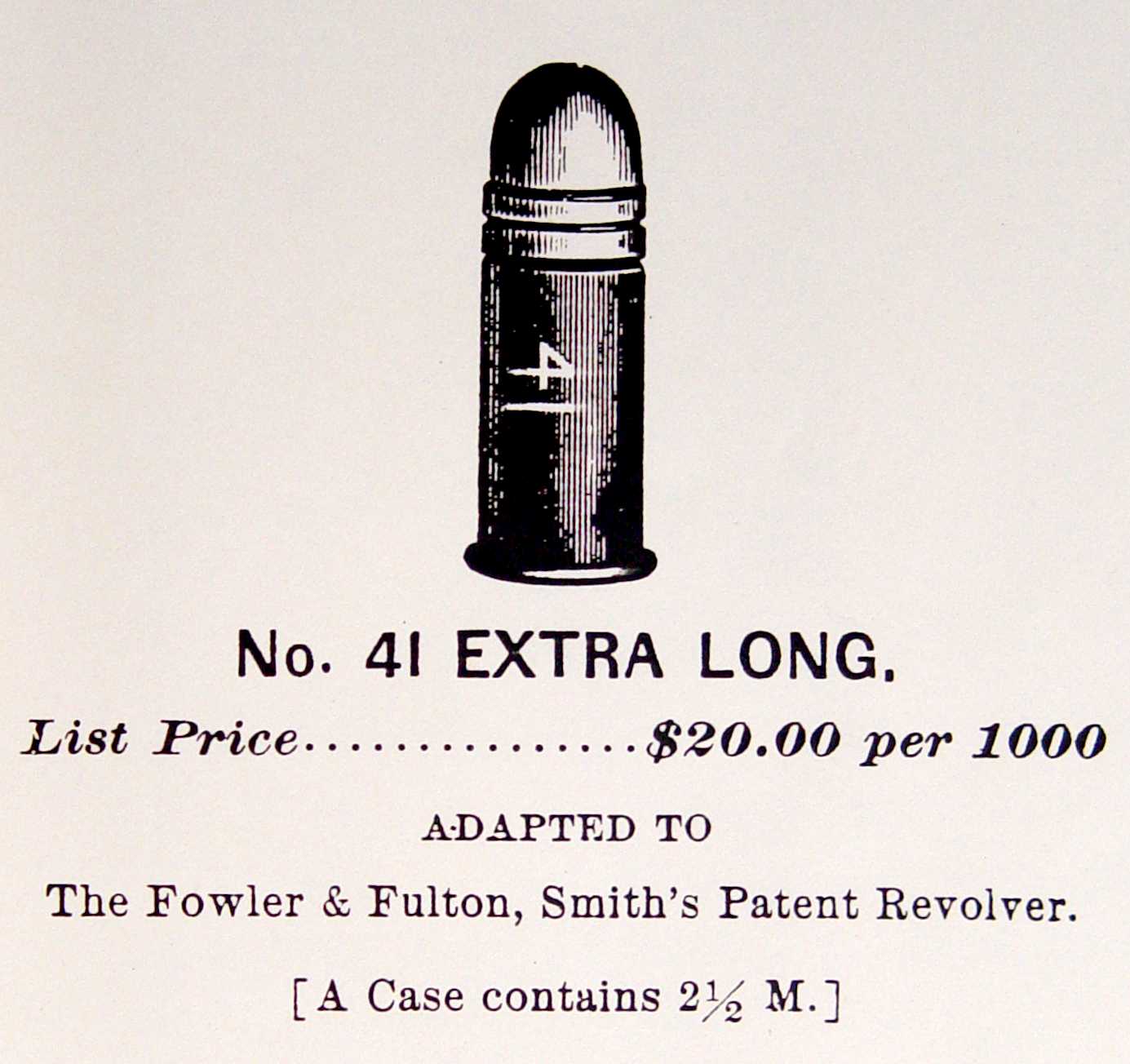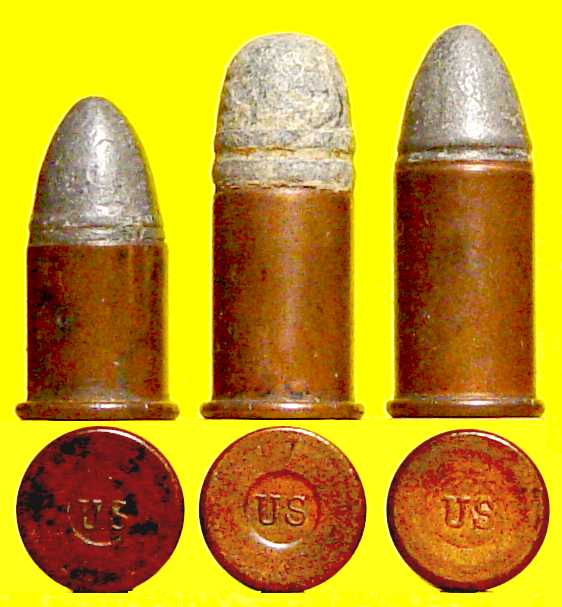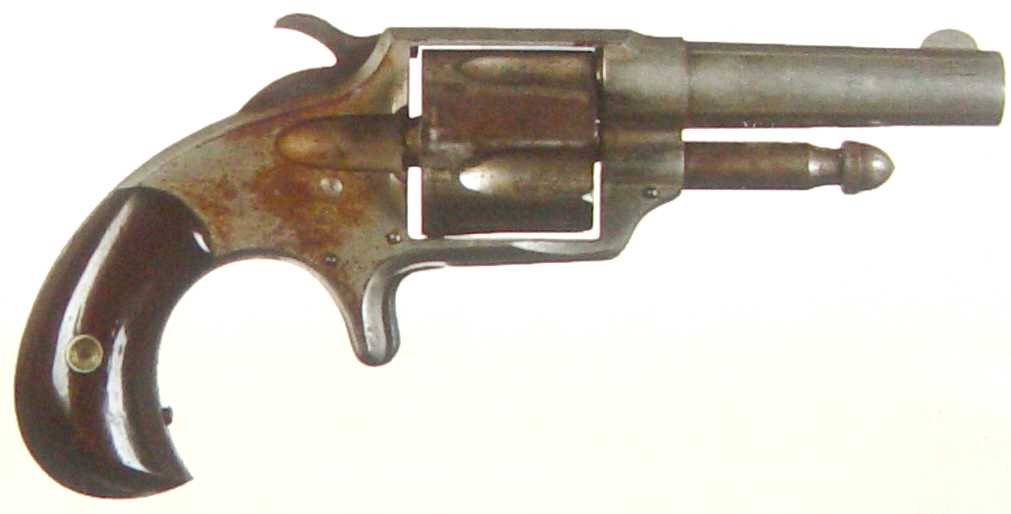|
THE CARTRIDGE COLLECTOR'S EXCHANGE |
| Contents
Cartridge
Lists
Prior Picture Pages:
Links to Other Sites
Cartridge Collectors Organizations:
Auctions:
Books:
Other Collector's Sites:
|
Home of the Old Ammo Guy's Virtual
Cartridge Trading Table
Picture Page May 2009 A trio of .45 British Whitworth cartridges....... Sir Joseph Whitworth is credited with developing a rifle for the British
Army which bore his name, and which had a hexagonal bore that used a long
six-sided bullet molded to precisely fit the bore. In 1863, the British
government contracted with Whitworth to supply them with 8000 of his rifles,
which saw limited use due in part to the high costs associated with
producing the rifle, and ultimately, to the development of the adoption
of the Snider breech-loading system in
1866. A number of his rifles were also purchased by the Confederate Army
during the American Civil War for use by their sharpshooters. During the
siege of Charleston, South Carolina, sharpshooters using these rifles picked off Union soldiers manning the
cannons at Fort Wagner that were firing on the city at ranges of up to 1500
yards.While less interesting
but more common (and more affordable) than their hexagonal cousins,
Whitworth rifles were also produced that used round bullets; I've included pictures
here of several
of the pre-loaded
These loading tubes contained a pre-measured powder charge, a wad, and
the cylindrical bullet. To use the loading tube, the tear tab was pulled up
to remove a paper cover over the end of the tube that held the powder, which
was dumped down the bore. Then the bullet and wad were pushed through the
the tube with the ramrod and down the barrel until they were seated against
the powder. The longer tube in the picture of the three tubes above held the
powder in the smaller diameter portion, while the bullet was in the larger
diameter portion. Slits in the side of the tube allowed it to expand as the
bullet was pushed through. . .
Three USC Co .41 rimfires...........
A documented example of the .41 Extra Long as illustrated in the USC Co
catalog has not surfaced, but in 1987 a small number of .41 rimfire
cartridges with cases longer than the .41 long, and loaded with pointed .41
short style bullets were found by a New Hampshire cartridge collector. The
cartridges were in pristine condition and were Also in 1987, John Barber published The Rimfire Cartridge in the United States & Canada, which included a picture and discussion of one of these extra long cartridges with the pointed bullet, which I assume was one of the New Hampshire cartridges. His remarks leave some doubt as to whether this is actually the elusive .41 extra long, due to the inconsistency of the bullet shape and the presence of the headstamp on these cartridges, which would place its production four years or more after the 1881 catalog date, as USC Co did not begin using headstamps until about 1885. Robert Buttweiler included four of the New Hampshire cartridges in his auctions beginning in 1989 (Collector's Ammunition, Volume VI, Number 3), and his descriptions leave little doubt that he believed this to be the .41 extra long regardless of the shape of the bullet. I would have to agree with him, and attribute the pointed bullet to an error made in the illustration, or less likely, a production change made by the company, which would mean there would be two variations of this cartridge for us collectors to look for.
Regarding the 'Fowler & Fulton, Smith's Patent Revolver' noted in the
catalog, Buttweiler mentions in his Volume X, Number 3 description for the
last cartridge he auctioned that he had not been able to locate any
information on Fowler & Fulton, but that the Smith patent revolver cited may
be the Otis A. Smith type produced in the 1870 to 1890 period. When I began
looking for information on Fowler and Fulton beginning shortly after I
obtained my cartridge in 1987, I assumed they were manufacturers of
revolvers, but had been unable to locate anything on either a Fulton, a
Fowler, or a Fulton & Fowler revolver over the
.
.303 British cartridges made in Iraq......
With the coverage of the war in Iraq, all one typically sees in the news
stories are automatic weapons being used by fighters on both sides, I can't
help but wonder what happened to all of the old British Lee-Enfield bolt
action rifles that were used by the Iraqi Army beginning with the British
administration of that country shortly after World War, and continuing in
use until well into the 1950s. Ammunition for these rifles was first
produced in Iraq beginning in the mid 1930s, using equipment purchased from
the British firm Greenwood and Batley. This would explain the very 'British'
appearance of the Iraqi-made ammunition. Everything about them looks
British, from the three neck stakes that hold the bullet in place to the
finish and appearance of the metal, and the flat Berdan primer to the
lengths of cordite that fill the case. The headstamps, however, make the
Arabic connection to this ammuniton very obvious. Two examples of these
cartridges are shown above, one produced in 1935 (on the left) and the other
in 1957. The 1935 . .
|

 Whitworth charging tubes which utilized these round
bullets. I don't generally go looking for the pre-metallic cartridges for my
collection, as the ones I have
managed to accumulate in the last 30 or so years have had a tendency to
slowly self-destruct over time. It is terribly disappointing to go looking
for a paper cartridge only to find that it has been reduced to a naked
bullet comfortably nestled in a mixture of powder and paper particles - this in spite of the fact
that I keep them all in a separate 'fragiles' container and try to handle
them as little as possible.
Whitworth charging tubes which utilized these round
bullets. I don't generally go looking for the pre-metallic cartridges for my
collection, as the ones I have
managed to accumulate in the last 30 or so years have had a tendency to
slowly self-destruct over time. It is terribly disappointing to go looking
for a paper cartridge only to find that it has been reduced to a naked
bullet comfortably nestled in a mixture of powder and paper particles - this in spite of the fact
that I keep them all in a separate 'fragiles' container and try to handle
them as little as possible.  These grooves can be seen in this picture of the two shorter tubes.
Oxidation of the bullets has caused the tubes to expand, opening the slits
on both tubes. The cannelure seen on the right end of these two tubes was
intended to keep the bullets from sliding out of the open ends of the tubes.
These grooves can be seen in this picture of the two shorter tubes.
Oxidation of the bullets has caused the tubes to expand, opening the slits
on both tubes. The cannelure seen on the right end of these two tubes was
intended to keep the bullets from sliding out of the open ends of the tubes. Typically,
when one thinks of American .41 rimfire cartridges, only two come to mind - the .41
Short and the .41 Long. That pretty much covers the
possibilities for all US ammunition makers except one, that one being the
United States Cartridge Company. In their 1881 catalog, they include the .41
Short and Long, as well as a .41 Extra Long, which they show as being
adapted to the Fowler & Fulton, Smith's Patent Revolver. The
illustration in the catalog shows a belted round nose bullet with a single
exposed groove.
Typically,
when one thinks of American .41 rimfire cartridges, only two come to mind - the .41
Short and the .41 Long. That pretty much covers the
possibilities for all US ammunition makers except one, that one being the
United States Cartridge Company. In their 1881 catalog, they include the .41
Short and Long, as well as a .41 Extra Long, which they show as being
adapted to the Fowler & Fulton, Smith's Patent Revolver. The
illustration in the catalog shows a belted round nose bullet with a single
exposed groove.
 headstamped
with the raised 'US' in a depression. I had the good fortune to trade for
one of these cartridges in December of that year, which is shown on the
right in this picture, along with a .41 short and .41 long, also made by USC
Co. The case length of the extra long cartridge is .723", that of the .41
long is .635"
headstamped
with the raised 'US' in a depression. I had the good fortune to trade for
one of these cartridges in December of that year, which is shown on the
right in this picture, along with a .41 short and .41 long, also made by USC
Co. The case length of the extra long cartridge is .723", that of the .41
long is .635"
 intervening
years. While trying to locate a good picture of an Otis Smith .41 rimfire
revolver (which I include here, obtained from www.simpsonsltd.com) for this
write-up , I solved the mystery when I stumbled upon Google's digitized copy
of the Sportsman's Gazetteer & General Guide published by Charles Hallock in
1877. On page 671, under Sportsmen's Outfits is "Guns, Pistols, and Sporting
Goods, Fowler & Fulton, 300 Broadway, N. Y. Their specialties are: Smith's
patent revolvers, Maynard rifles ...". This indicates that Fowler & Fulton
were nor makers of revolvers, but rather, agents for the Smith patent revolver, which was Otis Smith's line of
revolvers. These were typically marked on the barrels 'SMITH'S PATENT
APR. 15, 1873'. It is also possible that USC Co produced the .41 Extra Long
cartridge specifically for Fowler & Fulton to market with the Smith
revolvers, since the catalog lists only one revolver as using the cartridge
and specifically mentions Fowler & Fulton by name. It would be interesting
to see what was printed on the original box label for these cartridges.
intervening
years. While trying to locate a good picture of an Otis Smith .41 rimfire
revolver (which I include here, obtained from www.simpsonsltd.com) for this
write-up , I solved the mystery when I stumbled upon Google's digitized copy
of the Sportsman's Gazetteer & General Guide published by Charles Hallock in
1877. On page 671, under Sportsmen's Outfits is "Guns, Pistols, and Sporting
Goods, Fowler & Fulton, 300 Broadway, N. Y. Their specialties are: Smith's
patent revolvers, Maynard rifles ...". This indicates that Fowler & Fulton
were nor makers of revolvers, but rather, agents for the Smith patent revolver, which was Otis Smith's line of
revolvers. These were typically marked on the barrels 'SMITH'S PATENT
APR. 15, 1873'. It is also possible that USC Co produced the .41 Extra Long
cartridge specifically for Fowler & Fulton to market with the Smith
revolvers, since the catalog lists only one revolver as using the cartridge
and specifically mentions Fowler & Fulton by name. It would be interesting
to see what was printed on the original box label for these cartridges.